Introduction: In this article, Duncan Kuehn explores the history of American mail and shows how the mail system and newspapers have been closely connected—with the postal system delivering newspapers, and newspapers doing the work of the post office by alerting readers to unclaimed mail. These “uncollected mail” lists in old newspapers are a valuable genealogy resource for family history researchers. Duncan is a professional genealogist with over eight years of client experience. She has worked on several well-known projects, such as “Who Do You Think You Are?” and researching President Barack Obama’s ancestry.
The postal system and newspapers—especially lists of uncollected mail—have long been connected in American history, and provide another avenue of research for family history researchers.
Mail in Colonial America
The first organized mail service in colonial America began in 1692, mostly to get mail to and from Europe. The first postmaster was Andrew Hamilton, the governor of New Jersey. Then England purchased the project in 1707 and appointed Andrew’s son John as the Crown’s official postmaster.
England had a long history of interfering in colonial American communications. For example, there was the Stamp Act, the closure of colonial newspapers that seemed to criticize the Crown, and the search and seizure of private papers.
Ever the innovator, Benjamin Franklin instituted the penny post concept. Mail was delivered to the post office and the recipient was to pick it up there. However, for a penny, Franklin would have it delivered to the person’s home or office. Franklin was removed from his position as postmaster due to his revolutionary leanings.
Franklin was also a newspaper man. At that time newspapers were produced as a way for printers to make a little on the side when the press didn’t have any other work. These newspapers were often sent by post to distant locations. Franklin was an advocate of getting the mail (and the news) out on time, and with the best business practices he knew.
Genealogy Tip: Newspapers published lists of people who had letters waiting for them in the post office. Checking these lists can help you pin down your ancestor to a place and time.

History of the American Postal Service
As things heated up between England and the American colonies, mail services became even more challenging. One way to subdue an enemy is to prevent communications between those in charge and the troops on the ground. Since the Crown owned the mail system, they held the advantage in communications.
The Battle of Concord was in April of 1775. The following month the primary business for the Continental Congress was to establish a mail system. Benjamin Franklin was the obvious choice for the first postmaster. Originally, the main purpose of the postal service was to get news and information out for military purposes.
Newspapers of the time, which focused on business and politics, were anxious to get information from other states. Many newspapers lacked much actual news reporting and simply parroted months-old news from other papers. They would subscribe to distant newspapers and would copy the articles word for word into their own paper. The lack of any copyrights allowed this to occur without even an attribution of the original writer or publishing newspaper. In fact, there was rarely an acknowledgement of the author in the original paper. News was published anonymously. (It wasn’t until World War I that the author of each article was regularly listed. This was a military move to ensure that the author was held accountable for the information he or she disseminated that might go against the censorship laws.)
During this time the paper’s printer was also the publisher, editor, and news collector all wrapped into one. Using other newspapers’ articles allowed them to publish more information with limited investment. This early newspaper practice means that you may find information about your ancestor in distant newspapers.
Genealogy Tip: Begin your searches in GenealogyBank’s Historical Newspaper Archives nationwide rather than just selecting one state’s papers to view, since news was published far away in places you wouldn’t expect.
Newspapers not only used the mail service to gather information, but also to disseminate it. Readers could subscribe to a newspaper regardless of where they lived and have it delivered via the postal service. This increased the number of potential readers for a paper, thereby increasing the print load and profits of a newspaper service. This eventually led to the need to hire more staff and to increase the speed of the printing process. The news could become a business in its own right instead of a side job to keep the printing press busy.
This map shows an old trail that was used for “mail and express service” in Missouri.

Uncollected Mail
Originally, mail was delivered to the post office and recipients stopped by to collect it. In the city, large companies hired clerks to make the mail run, carting mail to and from the post office multiple times a day. In rural areas, the post office became a place to gather, especially in more isolated areas. Going to get the mail was a big deal. Families dressed up to go to town to collect the mail and spend time socializing with their neighbors. However, not everyone could make it out every month to check for mail. When an item of mail remained uncollected at the post office, an advertisement was run in the local paper to alert the intended recipient. This is a valuable resource for modern-day genealogists.
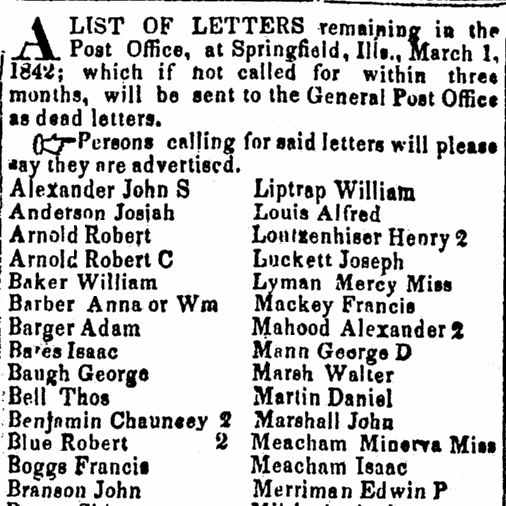
Genealogy Tip: These lists show the names of people (women and men) who lived in the area. This can help a family history researcher establish the location of an ancestor.
This resource is especially beneficial in instances where two or more people who initially appear to be one and the same can now be separated, thanks to these mail lists. In addition, the appearance of a name over several months can indicate that the person in question may have moved, was ill, was temporarily out of the area, or possibly even dead. This is an alert for the genealogist to do more investigation into their ancestor’s life during the time the name appears. Because women also received mail, their name may be listed. They may even be listed by their own name and not by the more commonly used feminized version of their husband’s name: Mariah Johnson rather than Mrs. Simon Johnson.
It would be especially helpful to find the name of an ancestor in a list of letters remaining at the post office in the place they had just moved from. For example, if you know Simon Johnson was living in Crawford County, Indiana, after 1845—but you weren’t sure where he moved from—you could search for Simon Johnson’s name in the postal lists. Finding his name in a Randolph County, North Carolina, mail list prior to 1845 would not prove that he came from there. However, it does provide a clue to begin searching for him in the records in that area.
One thing to keep in mind is that the lists were often alphabetized by the last name. This means the name will appear last name first: “Johnson, Mariah.”
Genealogy Tip: Entering a first and last name into GenealogyBank’s search engine will allow for the name to appear in reverse order, so no special search techniques are needed. However, you can narrow the results by entering a keyword such as “letters,” “post office,” or “mail.” Use only one keyword at a time and remember that the word must appear in the article exactly as you typed it.

Unfortunately for us, the actual “unclaimed” letters did not appear in the newspapers. Although many letters were republished in newspapers because of their informative nature, that was done by consent and not because they were unclaimed. The unclaimed letters lists were simply lists of people’s names.
Expanding the American Mail Service
The goal of the postal system has always been to reach every person. As the population spread across the newly created country, the mail system improved roads to reach them. As the postal roads became safer and more passable, more people moved to outlying areas. And so a chicken and egg situation was created. Did migration expand the postal system or did the postal system increase migration? The answer is: “yes.”
Newspapers were certainly not the only pieces of mail that went through the postal system. But to give an idea of how many newspapers were being delivered around the country, Richard R. John in Spreading the News claims that the post office delivered 2.7 newspapers per person in 1840!* Outside of the largest urban areas, the news was still delivered weekly at this point. But that is still a lot of mail!
By 1847, stamps were minted and the sender now paid the postage. Building on Franklin’s penny post delivery system, the postal service delivered the mail for two cents. In 1863, urban mail was delivered for free—if the city had adequate sidewalks and street lighting in addition to named streets and house numbers. Sixty-five percent of the American population lived outside of these metropolises in the 1890s when rural mail delivery finally became free.** Mail boxes began in 1912 and were required by 1923.
Here’s subscription information for the Idaho Statesman in 1898, giving terms for delivery by mail or carrier.
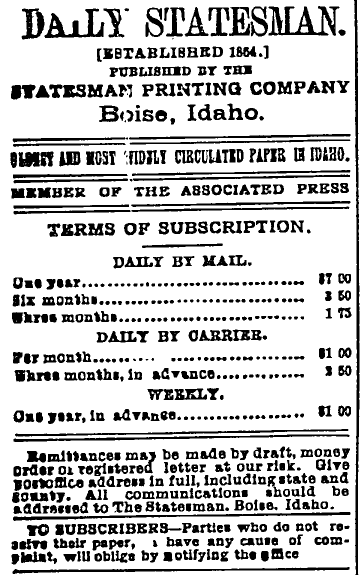
Lost Mail a.k.a. Dead Letters
Sometimes, mail was lost or became undeliverable. The “dead letter office” began in 1825 to gather all of these documents. The local post office was required to advertise the existence of the mail in the newspaper before forwarding it on to the dead letter office. Once there, any valuables were removed and the rest of the letter was burned. This office has a long and interesting history that can be found in the newspaper archives.
Genealogy Tip: Enter the phrase “dead letter office” into the “Include Keywords” field in the search box to find articles.
Here is a sampling of dead letter office articles.
In 1925 in just one post office, 200 letters had been sent in “absolutely blank envelopes,” 600 parcels had been mislabeled, and an astonishing 20,000 letters in one year had been forwarded to the dead letter office!
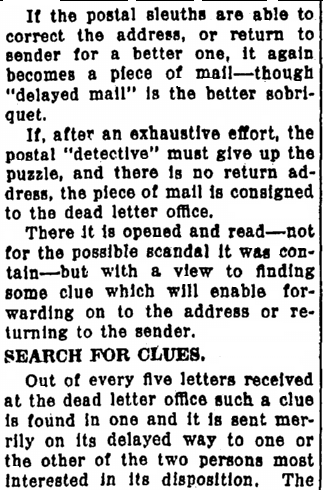
Here is an excellent and informative article from 1846.
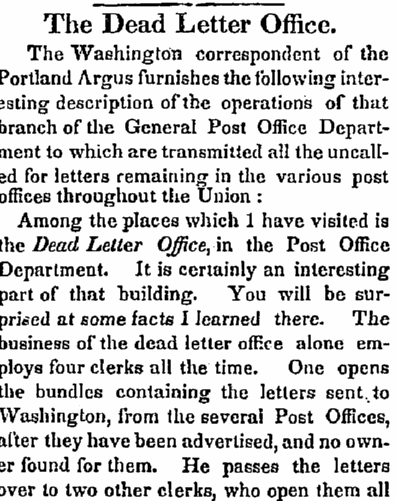
Here is a picture of a dead letter office from 1985.
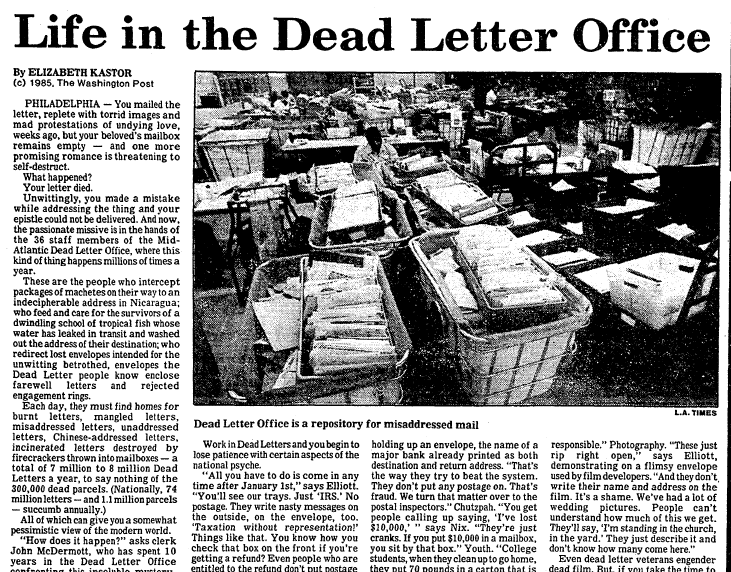
So don’t forget to include mail lists in your searches. These informative lists are another example of how valuable newspapers are to family history research.
——————
* Richard R John, Spreading the News: The American Postal System from Franklin to Morse (Cambridge: Harvard University Press, 1998), p. 4.
** The United States Postal Service, An American History 1775-2006 (Washington DC: Government Relations, 2012), p. 22.
Related Articles about Researching Old Letters & Mailings:

Is there a comprehensive resource where dead letter lists are compiled at one dedicated site? I have, on many occasions, discovered lost family members who may have left home, bound for destination certain, but waylaid in a new country! A single mention in a local publication then leads to other confirmation.
Unfortunately, there is not a comprehensive list. It would be extremely lengthy if there were!
However, you can easily find the articles by including the keywords “post office” in the include keywords search field. Put the words in quotation marks to keep them together as a phrase.
I’m glad you have found these lists as helpful as I have! Best of luck in your continued research.
I worked for the US Postal Service for many years. I did not know many of these things that are related here. Thank you for this information.
We’re glad you enjoyed the article, Jan. Thanks for writing us.